Editor's Note:
Dear Friend,
I spent a whole lot of time this morning in an awful traffic jam. As the cars inched forward, I wondered what was holding us up. Was it roadwork, or something more sinister? Should I check Waze? Then I finally saw the problem: a traffic light wasn’t working. Those wishing to cross the intersection were making baby advances into the melee, and those poor people needing to turn left . . . I fear they may still be waiting.
That got me thinking that one of the most important things we can do as parents is create “traffic lights” for our children, telling them what is red and what is green. What is allowed and what isn’t, where to go and which lines not to cross. And there are the yellow lights as well, some of which are to be treated as red, and others which are okay in a pinch.
Come to think of it, we adults can probably use a few internal traffic lights as well.
Have a great week.
Mendy Kaminker,
on behalf of the Chabad.org Editorial Team
P.S.: What do you think about internal traffic lights? Pro or con, or perhaps this is a “yellow”? Please share your thoughts in the comments section.

Personal Trainer
All of us come with a built-in spiritual fitness trainer.
The trainer’s job is to gauge our spiritual capacity at every step and adjust our program accordingly. Just when things start getting too easy, our trainer will turn up the friction on the standing bicycle or add more weights to the pulley lift.
This innate personal trainer has many titles. It’s crucial to know at least some of those titles. If you don’t know the identity of this trainer, you might get the idea that you are failing when really you’re making great progress.
Most popular title: “the beast within.”[See Tanya, book 1, chapter 28]
This Week's Features:
Printable Magazine

Watch the Rebbe Retell a Story About the Previous Rebbe

http://www.chabad.org/therebbe/livingtorah/player_cdo/aid/2971944/jewish/Never-Too-Young.htm
http://www.chabad.org/2971944
VIDEO

Practical Halachah: The Three Weeks
Learn the laws and customs for the mourning period of the “Three Weeks,” which begin with the fast of 17 Tammuz, and culminates with the fast of Tisha B’Av.
By Rabbi Yosef Shusterman
 Watch (16:50)
Watch (16:50)
<script language="javascript" type="text/javascript" src="http://embed.chabad.org/multimedia/mediaplayer/embedded/embed.js.asp?aid=2986210&width=auto&height=auto"></script><span style="clear:both;" class="lb" id="lbdiv">Visit <a href="http://www.chabad.org/multimedia/default_cdo/aid/591213/jewish/Video.htm">Jewish.TV</a> for more <a href="http://www.chabad.org/multimedia/default_cdo/aid/591213/jewish/Video.htm">Jewish videos</a>.</span>
More in Video:
• Balaam’s “Believe It or Not” (By Mendel Kaplan)

Watch the Rebbe Retell a Story About the Previous Rebbe

http://www.chabad.org/therebbe/livingtorah/player_cdo/aid/2971944/jewish/Never-Too-Young.htm
http://www.chabad.org/2971944
Parshah
| ||||||||||||||||||||||

Near the beginning of the prayerbook there is a passage from this week’s Torah reading. The Torah tells how Balaam, a non-Jew with spiritual power, tried to curse the Jewish people. Each time, G‑d forced him to give a blessing instead.
This happened twice. The third time was different. Balaam, standing on a hilltop overlooking the camp of the Jews, underwent a temporary change of heart. He himself was moved to give them a blessing: “How good are your tents, Jacob . . . they are like gardens by the river, like fragrant herbs planted by G‑d . . .”1 Rashi’s commentary tells us why Balaam was so moved by the sight of the tents of the Jewish people. From the way they were pitched, he could sense an atmosphere of modesty and privacy. From the entrance of one tent you could not peep inside the entrance of any other. It was clear to Balaam that in this nation, the Jewish people, there was great respect for the integrity of family life and for the sanctity of the person. The opening words of Balaam’s blessing entered the prayerbook, and have been repeated daily for thousands of years by Jews all over the world.2 The values expressed in these words have contributed, together with many other aspects of Judaism, to the comparatively high level of stability in Jewish family life. The ideal of modesty applies to both men and women. It relates to clothes, behavior, speech and thought. Why is modesty considered so important in Jewish life? A basic human perception is the idea that something holy is also something special, kept apart, reserved, even hidden. For example, due to the holiness of the Temple, one could not always go there, and certain areas were restricted to kohanim, the priests. The Holy of Holies could be entered only once a year, on Yom Kippur, and then only by the high priest. Similarly, a Torah scroll is generally kept hidden. It is kept wrapped in its mantle or silver case in the ark, unless it is actually being read in the synagogue. If for some reason it has to be taken from one location to another, it is usually wrapped in a tallit. These images suggest ways in which one might respect the sanctity of the human body, created in the divine image, with the task to make the world a dwelling for the divine. By contrast, today we live in an epoch of communication. This is a very positive aspect of our society. Yet communication needs to have limits. The idea that one can reveal everything and say anything can be of great value in appropriate situations. Yet, used unwisely, it can also be harmful to the basic sanctity of the human being and the world. It is a simple fact of life that modesty is particularly at risk when one is in a “tent,” when traveling, on holiday, in a relaxed and less guarded mode. Yet it was the modesty expressed by the Tents of Jacob which impressed Balaam, and transformed his desire to curse into the desire to give a blessing.3 Our role as Jews is to be an example. The Torah describes us, thousands of years ago, as expressing the virtues of modesty and privacy. Through affirming these values now, we can help make a world in which every detail of life is illuminated by the radiance of the divine.
Dr. Tali Loewenthal is Lecturer in Jewish Spirituality at University College London, director of the Chabad Research Unit, author of Communicating the Infinite: The Emergence of the Habad Schooland a frequent contributor to the Chabad.org weekly Torah reading section.
© Copyright 2015, all rights reserved.
| ||||||||||||||||||||||
Parshah
| ||||||||||||||||||||||

Dear reader,
When I was growing up, my father often brought unusual guests to our Shabbat table. My sisters and I referred to one of these guests as “Mr. Mna Mna.” He would guzzle down my mother’s delicacies, spilling some on our pristine white tablecloth. When the piping hot chicken soup was served, he’d slurp it, making loud “mna, mna” noises—and thus our nickname. I don’t remember my father hearing us call “Mr. Mna Mna” by this name; he wouldn’t have been pleased. But I do remember my father according him the greatest respect, sitting him at his side and kindly offering him food first. As a child I wondered if my father hadn’t noticed the man’s strange behavior, but I couldn’t believe that he hadn’t smelled his foul body odor. No matter; week after week, Mr. Mna Mna returned. As I grew older, I became aware that Mr. Mna Mna was not unique to my family. Look around and you will see Mr. and Mrs. Mna Mnas in Jewish communities the world over. They are invited for a nourishing meal, given fresh clothing or just a listening ear—whatever kindness the hour calls for. I have a friend with a big heart who lives in a small house. She is constantly rearranging her (willing!) children, moving them out of their bedrooms to sleep the lonely souls that end up on her doorstep. Another friend, a successful businesswoman, clears her calendar once a week to visit lonely elders. She says she does it for herself, that it brings her joy. Another friend is training for a marathon to raise money for children with terminal illness, while another, a working mother, spends her Sundays at a center for special-needs children. None of them consider their actions special. We often notice—and focus on—the faults in our communities. This is important because in order to improve, we cannot be blind to our culpabilities. But it is also worthwhile to acknowledge all the good that is being done—all the hearts that are so big, all the kindness that abounds. Ever ask someone who returned to their Jewish heritage what motivated them? Rather than deep philosophical and theological responses, I’ve often heard about simple-to-goodness deeds. Witnessing the love, care and deep pockets of a Jewish community made them want to be a part of whatever religion and peoplehood was causing this. In this week’s Torah portion, Balak, the king of Moab, summons the Jew-hating prophet Balaam to curse the people of Israel. Instead he ends up extolling their virtues, among which he declares: “For from their beginning, I see them as mountain peaks, and I behold them as hills. . . . How goodly are your tents, O Jacob; your dwelling places, O Israel!” Indeed! Wishing you all a week exploding with kindness! Chana Weisberg, Editor, TJW
Chana Weisberg is the editor of TheJewishWoman.org. She lectures internationally on issues relating to women, relationships, meaning, self-esteem and the Jewish soul. She is the author of five popular books.
© Copyright 2015, all rights reserved.
| ||||||||||||||||||||||
Judaism 101
| ||||||||||||||||||||||

Congratulations, it’s a boy! A friend or family member has given birth to a baby boy, and now you are invited to the ceremony—known as the brit milah, or brit(alternately pronouncedbris milah or bris)—when Jewish boys are circumcised, brought into Abraham’s covenant with G‑d, and named.
What is expected of you at a traditional brit milah, and what should you expect? General InformationUnlike many Jewish lifecycle events, formal invitations to a brit milah ceremony are not sent out. If you have been notified of the time and place of the brit by phone, e‑mail, or even a general announcement or Facebook post, you can take this as your invitation and know that you are wanted.In most cases the brit milah will be held on the eighth day after the baby was born, as per the biblical command. (If the baby has jaundice or other health problems, the brit milah will be postponed until the baby is in good health.) The brit milah is also usually conducted first thing in the morning, to show that now that the appointed day has arrived we are eager to perform the mitzvah of circumcision without delay. The event is not very formal—guests come as they are, and often leave straight afterwards to school or work—and children of all ages are generally quite welcome. Even if this is your first time attending a brit milah, there is not much you need to do to prepare. What to Wear, What to BringA brit milah is not as formal as a bar mitzvah or a wedding. Whatever you would normally wear to a religious service is fine. If you are a woman, you will likely feel most comfortable in a modest top and skirt, or a modest dress. If you are a man, come wearing a kippah—if you don’t have one, a baseball cap will do in a pinch. There will also likely be some kippot available to borrow.It is appropriate, though not necessary, to bring a small gift (of a baby outfit, toy, or gift for the older children, if there are any). If you were going to give a baby present anyway, now is a good time. Circumcision and Naming CeremonySince the mitzvah of circumcision is such an important one, multiple people will be called upon to say things or hold the baby, and any of these roles are considered an honor. There are also a few points at which the entire crowd will participate. All the speaking parts will be in Hebrew, but don’t worry if you are not able to understand or recite the words. Just the fact that you are there is valuable.If the brit milah is taking place in a synagogue, the ceremony may take place immediately following the morning prayer services. If this is the case, seating will likely be gender-segregated. You can find a spot in the appropriate section and follow the prayers as best you can, or just listen. The text for the circumcision ceremony can be found on page 409 of the Siddur Tehillas Hashem. When the time for the ceremony arrives, the mother will hand the baby to the kvatters (messengers) who will carry the baby, on a special pillow, to the part of the room where the mohel (trained ritual circumciser) will perform the circumcision. When the baby will be carried in, everyone will welcome the baby with the words “Baruch haba!” The baby will first be gently placed on a special chair called Elijah’s Chair (according to tradition, the prophet Elijah attends every brit). He is then picked up and held by one of his grandfathers, or another older respected man, who sits in the chair (or another one). While the baby is thus being carefully held, the mohel will recite a blessing in Hebrew (translation: “Blessed are You . . . King of the Universe . . . Who has commanded us concerning circumcision”), and the mohel will skillfully perform the circumcision. You may hear a cry when the mohel performs the circumcision (or possibly just removes the baby’s diaper, bringing a rush of cold air), but the baby will be quickly soothed with a few drops of wine and soon brought back to his mother. The father or another honoree will recite another blessing in Hebrew (translation: “Blessed are You . . . who has commanded us to enter him into the covenant of Abraham our father”), and the crowd will respond in Hebrew, “Amen! Just as he has entered into the covenant, so may he enter into Torah, into marriage and into good deeds.” Immediately thereafter, the mohel or another honoree will name the child while holding a cup of wine. There are a few verses here as well that the crowd calls out. Since traditionally Jewish parents do not divulge the baby’s name prior to the naming ceremony, along with calls of “Mazel tov!” you will likely also notice murmurs going around the room as those who heard clearly the baby’s name clue in those of their neighbors who missed it. Festive MealAfter the circumcision and baby naming, guests will move to wash their hands for bread, and then sit down to eat a festive meal. Some communities will have gender-segregated seating for the meal, so take your cues from those around you, but aside from that there are no set rules, so wherever you find a spot, make yourself comfortable.Since it is often still early in the morning, a brunch-style meal is often provided. Though meat is actually halachically preferred (a little-known fact!), the most common brit menu features bagels, cream cheese, and lox or smoked fish. Whatever the time of day, the mood at a brit is joyful and casual. A rabbi or the baby’s parents may give a short speech, often about the name and why it was chosen. If the child was named after a departed relative or mentor, the speech may be about the baby’s namesake and express the hope that the baby will grow up to live in his ways. You can tell the parents or other relatives “Mazel tov,” “Congratulations,” or whatever feels natural to you to express your joy at the birth of the baby. Comments on how cute the new baby is are appropriate, as are compliments on the name given. After the meal winds down, Grace After Meals will be recited, including six stanzas added specifically for the occasion. If there is no waitstaff, your help cleaning up will be appreciated. Feel free to linger, or leave when you need to. There is no need to stay till the end of the event, as it is understood that guests will leave at different times depending on their personal schedules. Even if you cannot stay long, make sure you eat something before you go, as participation in the post–brit milah festive meal is considered an integral part of the mitzvah.
© Copyright 2015, all rights reserved.
| ||||||||||||||||||||||
Your Questions
| ||||||||||||||||||||||
 Question:My friend and I were having a little argument the other night. I lifted my glass of choice and wished him l’chaim, which I explained is a special Jewish toast that means “to life.” He said that there’s nothing unique about that kind of toast, and that many cultures—ranging from Armenians to native New Zealanders—say the same thing in their respective languages.So I ask you, dear rabbi, why do we say “l’chaim”? Is there a uniquely Jewish reason for this custom? Answer:You guys touched on a point of contention that is over 2,000 years old. Back then, people would toast to “wine and life to the mouths of the rabbis.” Some felt that this was a forbidden pagan superstition, but the Talmud countered this opinion by quoting a Tosefta1 that permits this toast. The Talmud also cited the precedent of Rabbi Akiva, who said this formula over every cup at his son’s wedding feast.2So we know that toasting “to life” is (at least) 2,000 years old, and is considered a Jewish custom. But why? What is so Jewish about it? There are a number of reasons given for toasting “to life.” (Or perhaps “for life” is a better translation of l’chaim.) Bad Stuff Happened When Wine Was DrunkAccording to one opinion, the tree of knowledge was actually a grapevine.3 Accordingly, Adam and Eve’s imbibing of grapes (or perhaps wine) brought death into the world.But it gets worse. After surviving the great flood, Noah planted a vineyard and became drunk, and you can read the disaster that followed in chapter 9 of Genesis. Then, in chapter 19 we read about Lot, whose daughters made him drunk and caused him to sin with them. Since alcohol consumption can easily lead to negative consequences, we express the wish that this drinking of wine be “to life.”4 Some even have the custom of spelling this wish out explicitly by toasting l’chaim tovim ule-shalom, “for good life and for peace.”5 To Life or Not to Life . . .The Midrash brings another fascinating explanation:After the judges of the Jewish court would deliberate on capital cases, they would turn to the witnesses once more and ask for their opinion: “Savri maranan,” “Attention, gentlemen . . .” If the witnesses opined that the plaintiff should live, they would reply, “L’chaim,” ”To life.” If, however, it was death, they would reply, “L’mitah,” “To death.” If the judges found the defendant guilty, he would be given very strong wine in order to diminish the pain of the execution.6 And so, when we drink our wine, we wish that it be “to life,” unlike the strong wine drunk by the person about to be executed.7 A Chassidic ApproachWhen hearing people toast “l’chaim,” Rabbi Dovber of Mezritch used to respond, “L’chaim velivrachah,” “To life and to blessing.” Once at a chassidic gathering, his disciple, Rabbi Schneur Zalman of Liadi, also responded, “L’chayim velivrachah.” After the gathering, a discussion about this expression ensued. One chassid proposed: “The Talmud states that ‘when wine enters, secrets come out.’”8When we drink wine, our emotions are revealed. However, this is something that requires a blessing that all go well, so we add on the word livrachah, “for blessing.” The Hebrew word livrachah can also be read as a contraction of two words, leiv rakah, a “sensitive (literally, soft) heart,” something we wish for. On a final note, when Moshiach comes, there will be a grand feast, at the conclusion of which we will toast l’chaim over the wine that G‑d has kept hidden for this special occasion since the dawn of creation9—may it happen soon.10 L’chaim!
Rabbi Yehuda Shurpin responds to questions for Chabad.org's Ask the Rabbi service.
© Copyright 2015, all rights reserved.
| ||||||||||||||||||||||
Your Questions
| ||||||||||||||||||||||
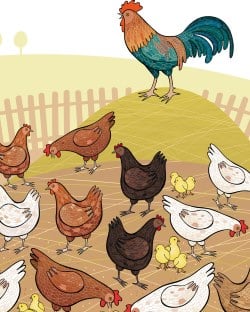
Just to magnify your question somewhat, you’ll note that Torah presents the original paradigm of marriage—that of Adam and Eve—as monogamous. Furthermore, virtually every instance of polygamy recounted in the Torah is related directly by the narrative to some sort of calamity—whether strife between competing wives, as was the case with Hannah and Peninah,1 or between rivaling half-siblings, e.g. Jacob’s2 and King David’s sons.3 Even the very verse4 in which the Torah provides a green light for polygamy frames it within an undesirable circumstance: “If a man will have two wives, one beloved and the other hated . . .”
Why, then, make room for trouble? If the ideal union of man and woman is an exclusive one, why should “a nation of priests and a holy people” compromise? The simple answer is that Torah deals with life on earth, and the gamut of social life and human experience over all of history and world geography is too diverse to be restricted to one narrow ideal. Take, for example, an agrarian society whose male population has been decimated by war. How are women to survive, and how is the population to replenish itself, without the mechanism of polygamy? Similarly, a man married to a barren woman who could not produce sons to help in the field and defend the fort would find himself ill-put to survive in those times. In an exclusively monogamous society, his wife would find her position insecure. Although in normative circumstances being “only one of many” compromises a woman’s value as a person, in these situations a permit for polygamy is a form of compassion. The only case of a polygamous rabbi recorded in the Talmud5 provides an excellent illustration: Rabbi Tarfon married 300 women. Why? Because there was a famine in the land. But Rabbi Tarfon had plenty of food, since he was a kohen and received the priestly tithes. The wife of a kohen is also permitted to eat those tithes. Those 300 women were very happy that the Torah permitted polygamy. Torah discourages abuse of this permit—not just by recounting the calamitous narratives mentioned above, but also by placing requirements on the husband. For every extra wife, no matter how lowly her status, a man must provide “food, clothing and conjugal rights” commensurate to her needs and his capacity, and equal to any other wives.6 Additionally, the husband must provide separate housing for each wife. Divorce requires involvement of a scribe, and the sages later instituted the ketubah as a further impediment of divorce. (See also Why is Jewish Marriage So One-Sided?) We see that these means were in fact effective—polygamy in Jewish circles was historically a rare exception. Rare, but necessary nevertheless. Even when Rabbi Gershom and his rabbinical court assembled to declare a ban on polygamy due to the conditions of their time (see previous link for more on this injunction), they nevertheless left the door open for extenuating circumstances. That loophole has proven vital in many an instance—for example, the case of a wife who has become (G‑d forbid) mentally incapacitated and is not halachically qualified to receive a divorce. You may wish to think of Torah as the DNA of a highly resilient organism called the Jewish people. Whenever circumstances change, this organism looks back into its DNA and finds some code that allows for an adaptive modality. There’s plenty off limits, but there is enough leeway to provide for every situation human life on planet Earth can throw at you. Proof is, we’ve been through it all—nomadic, agrarian, civilized, industrial, technological—and in every part of the world, and we’re still here, strong as ever.
Rabbi Tzvi Freeman, a senior editor at Chabad.org, also heads our Ask The Rabbi team. He is the author of Bringing Heaven Down to Earth. To subscribe to regular updates of Rabbi Freeman's writing, visit Freeman Files subscription.
© Copyright 2015, all rights reserved.
| ||||||||||||||||||||||
Your Questions
| ||||||||||||||||||||||
 Question:I am getting married two months from now, and last night we had a meeting with the rabbi who will be conducting the ceremony. Something came up that I am quite uncomfortable with: the issue of only the groom giving the bride a ring, and not vice versa. This essentially represents to me that I am being purchased. The idea that there is a problem with the bride also giving the groom a ring seems absurd to me. Surely I have as much say in the agreement to be married as my husband-to-be?I know I am allowed to give the ring after the ceremony. However, I want to exchange rings during the ceremony. Gender equality is a very important issue to me. I am a highly educated woman, and I also value my Jewish identity, but I am quite upset about this. I would like to hear your opinion. Answer:I fully understand your concern. Many couples have asked me the same question. Coming from a modern perspective, it does seem a little lopsided for the man to give the ring exclusively. But I believe when you learn the meaning of the ritual, you may feel differently.The chuppah is an exact spiritual “operation” to join your souls together. It is not just a ceremony representing your existing relationship, it is a life-changing event that creates a new relationship. Before the chupah you are two souls; after, you are one. Still two individuals, with two minds and two hearts, but a united soul. We can understand how two souls can become one by observing how two bodies can become one. The act of reproduction is the physical union of man and woman. In this bodily union, the man gives and the woman receives. Only in this way can new life be created, a child, in which man and woman have become one flesh. The physical world is a mirror image of the spiritual world, and the workings of the soul are reflected in the workings of the body. Just as physical intimacy is the union of bodies, the wedding ceremony is an act of spiritual intimacy, uniting souls. And so in this act of spiritual union, the man, expressing the masculine power of being a bestower, gives the ring to the woman, the feminine receiver. An exchange of rings doesn’t create unity, just as an exchange of seed for egg would not produce a child. Only when the groom gives the ring and the bride receives it does this singular act of his giving and her receiving produce oneness. Any attempt to alter that process would be, quite literally, counterproductive. We can’t play around with the facts of life. The spiritual life has facts too. May you and your partner be blessed with true oneness, and from that oneness may many little ones come. For further information on the halachic legalities of a double-ring ceremony, click here. Sources: Igrot Moshe, Even ha-Ezer 3:18 Rashi on Genesis 2:24 For a different approach to this issue, please see this question and answer as well.
Aron Moss is rabbi of the Nefesh Community in Sydney, Australia, and is a frequent contributor to Chabad.org.
© Copyright 2015, all rights reserved.
| ||||||||||||||||||||||
Current
| ||||||||||||||||||||||

Listen up, everyone: a very important event is about to take place. Take out your calendars . . . actually, take out your watches, because you will have to set them. We are about to gain one whole second!
It’s called a “leap second,” and it happens once every ten years. For those who are not familiar with the term (I wasn’t either), on June 30 a second will be inserted into our day, to help reconcile the slight discrepancies between the atomic clock and actual solar time. So the big question is: what are we going to do with that second? You see, in the old days a second wasn’t worth much. It was just a second, some minuscule unit of time that passes so fast we don’t even realize it. But we live in a different world. One second is exactly 1/15th of an Instagram video, 1/7th of a Vine. And you gotta agree that when your entire video is 7 seconds, every second is very important. Our attention span is much shorter, so each second is much more valuable. I am not sure we can really plan how to use that one extra second we are gaining, but I am sure we can start adding good to our lives in small bites. Take, for example, the way you approach a new mitzvah. It’s perfectly okay to say, “I’ll start learning Torah one minute per day,” “I will dedicate two minutes to prayer,” or “I will think for a few minutes about my children’s Jewish education” (yes, that’s a mitzvah too). Because a second used is a second earned.
© Copyright 2015, all rights reserved.
| ||||||||||||||||||||||
Women
| ||||||||||||||||||||||

“On that note,” David would say when he wanted to close a conversation, “I should get going. I have to (fill in the blank).” There was always something that demanded his attention, giving him an excuse to end our meandering telephone conversations. We talked about politics, philosophy, and what was happening in our own lives. The conversations were always pleasant, not too threatening, and enjoyable—until he was ready to hang up, which, “on that note,” we did.
I met David at a singles Shabbat program in the late 1980s. “Meet like-minded religious twenty/thirty-somethings from all over Israel in a pastoral setting,” the poster advertised. Sounded great to me. I went with a sense of anticipation, mixed with a little anxiety. At dinner I found myself sitting across from David. The conversations were always pleasant, until he was ready to hang upHe was smart, not bad looking, and had a real British sense of humo(u)r. After the meal ended, we continued talking for over an hour. Despite our different backgrounds—I’m from Los Angeles, he’s from London—we had a lot in common. I lived in Jerusalem and he in Ramat Gan, about an hour apart. We ate lunch together too, and seudah shlishit, the third meal. Saturday night, when everyone was saying their goodbyes, David approached me. After some small talk, he said, “Uh, why don’t we exchange phone numbers?” I gave him my business card, and he wrote his number on a small slip of paper. Two full weeks later, David called. He had ordered a book about dreams from a bookstore in downtown Jerusalem, and he just got notified that it had arrived. Would I like to meet him the next day at the bookstore? I had read enough of those “how to catch a man” books to know that I was not supposed to be overly available. And certainly not for the very next day! But, I considered, this didn’t seem like it was a date. It wasn’t like he was calling Friday for a date on Saturday night. Plus, I did want to see him. So I said I’d be happy to meet at the bookstore. We agreed to meet there at 5:30. Golly, I thought, 5:30 seems a little early for dinner. Then again, it wasn’t a dinner date. It wasn’t a date at all, really. What did he want anyway? Just some company at the bookstore? No, he must be interested in seeing me, or he wouldn’t have called, right? He did call. That does mean something. I think. Hmm. Should I eat ahead of time, so I won’t be hungry, or should I not eat, in case he does invite me out to eat? Do I dress up? Do I dress down? What’s a girl to do? The dress code in Israel is casual, even for work. So I decided to dress a tad nicer than usual, but not dolled up with pearls. I needn’t have worried. He came looking like a typical engineer, in a polo shirt and wrinkled khakis. He strolled in at 5:30 on the dot. “Great to see you!” he said with a friendly smile. I relaxed. He was happy to see me. And I was happy to see him. David picked up his book, and we perused the English titles, chatting about our favorite authors. We had read many of the same novels. David looked at his watch. “I have to be on the bus in a little over an hour, but that’s enough time to have a bite. Would you like to join me?” We went to a nearby outdoor café, and had the most delicious pasta I’d tasted. We talked about the book David had picked up, and his interest in dreams. I relaxed. He was happy to see meI shared a few dream stories of my own. When it was time to leave, I offered to split the bill, but David said, “Wouldn’t hear of it. I invited you, didn’t I?” We parted at the bus stop, and he said, “Let’s be in touch!” A couple of days later, he called and said he read something about a dream I told him about—that I found an extra room in my apartment that I hadn’t known existed. I’m always so surprised and delighted to discover I have more room. The book offered a couple of explanations. David went on to tell me about a recurring dream he’d had since he was a child—that someone was chasing him and caught him just as David woke up. He’s sharing with me something from his childhood! I thought. That’s a great sign! I had read in an article for men that if you want a woman to like you, tell her about your childhood. Women love that type of stuff! It means you want to be close to them, which you do want, right? The conversation went very well, until abruptly David said, “Well, on that note, I have to get going.” Huh? Why? It was such an interesting conversation. Well, maybe that’s why he had to go. David continued to call sporadically, and if I had a good excuse, I called him. One time, he called to tell me about a concert he’d heard about, which was scheduled for the following week in Sultan’s Pool, a popular outdoor concert venue in Jerusalem. Some philharmonic orchestra from Europe was playing Handel’s “Hallelujah Chorus” with a high-tech light extravaganza. Might I be interested in going? Might I be? Of course I’d be! This was pretty close to asking for a date. It meant going to an evening activity in what you could call a romantic setting. It sounded great to me. The concert was wonderful. David and I “ooh-ed and ah-ed” at the phenomenal light show. We gasped together at the sight of a long line of toga-clad men carrying torches from the entrance all the way up to the stage. It was a real feel-good experience. When it was over, David had to rush to catch his bus back to Ramat Gan. The next day I called him to thank him for the concert and to say how much I enjoyed it. We agreed that we should do something like that again. We never did. I never confronted David by asking, “Where do I stand?” or “Where is this relationship going?” because we didn’t really have a dating relationship. I didn’t find the opening to ask, and I was afraid that if I pushed things, David would I never confronted David by asking, "Where do I stand?disappear. But, the truth is, David never gave me a real reason for hope that our relationship would mature and change from anything other than what it was: a casual friendship. Even though it seemed like we got along so well, and had so much to talk about, I finally realized that whatever dreams I had about David and me were just dreams. I had to admit that having a relationship which would lead to marriage (oh no, that “m” word!) was about as real as the extra room I longed for. It seemed so crazy to me that a man in his thirties would not want to move a relationship from friendship to dating, if he was interested—which I thought he was. The phone calls continued, until I decided to take a leave of absence from my job and go back to school in the U.S. for a semester. There I met my husband, Yakov, and I came back to Israel engaged. I met Yakov at a Shabbat meal at a friend’s house in New York, and even though I was on my way to California, and he was on his way to Israel, well . . . you know the end of the story. He was really interested in a relationship, and he let me know it. We have been married for 24 years. And, David? Can you guess? Yes, he is still single, in his fifties. On that note, I have to go. I have to get ready for a date with my husband.
Jolie Greiff is a journalist and a mother. She lives with her husband and two children in Ramat Beit Shemesh, Israel.
© Copyright 2015, all rights reserved.
| ||||||||||||||||||||||
Women
| ||||||||||||||||||||||

You’ve had a long, tough day. You want to relax. So you open up your social media feed for a bit of virtual friendship—but you’re assaulted by disturbing images and stories that your friends have posted. You end up leaving the screen far worse than you arrived. Sounds familiar?
We know way too much. Information from every corner of the world comes flooding in, and much of it is not good—tragedy, terror, trauma . . . Many sensitive souls are having trouble sleeping We are an anxious bunchthese days, their minds filled with thoughts and pictures that disturb their rest. And this is all on top of the “normal” anxieties about health, safety, children, money, marriage, jobs, travel, our to-do list and much, much more. Children are also reporting a disconcerting increase in feelings of anxiety. They, too, are concerned about the world situation. But they are also concerned about bullies, cliques, academic performance, separation from parents, nightmares, death, pressures, phobias and all sorts of other things. We are an anxious bunch. What can be done about it? The Jewish ViewOur world can feel like a scary place, and many of us have fearful natures on top of that. But G‑d nonetheless asks us to bring ourselves to a state of calm confidence. In the Torah portion of Shoftim, soldiers are cautioned not to give way to fear, dread or panic on the battlefield.1 The commentaries state that a battlefield is a pretty scary place to be, and that fear is a natural response. However, the soldiers are admonished to keep their attention on the idea that G‑d is going with them into battle. By visualizing themselves resting safely in G‑d’s hands, they will be able to maintain a steady heart. Likewise, we are all soldiers in G‑d’s army. Our belief in G‑d’s omnipotence will help us quell our fears, and teach our children to do the same.Power of ImaginationModern psychology also acknowledges the power of attention and the power of imagination to change our emotional experience. When we picture bad things, we feel scared and our heart rhythm is disturbed. The disturbed heart pattern (the heart rate variability) is conveyed to the brain, which responds by sending out all sorts of fight-or-flight chemicals to the body. The resultant surge of energy is meant to help us deal with life-threatening conditions, but—when there is no actual life-threatening situation occurring—it simply courses through our body, causing our heart to beat rapidly, our breath to shorten and our palms to sweat. Picturing bad things is unpleasant emotionally, and also very hard on the body.Fortunately, picturing good things has the exact opposite effect. It produces a beautiful heart-rate variability pattern that communicates wellbeing to the brain, which causes a release of beneficial chemicals that calm, heal and renew the physical body. It is the picture—and the emotion that it elicits—not the thought that has all this power. Indeed, thoughts affect us only to the extent that they elicit pictures in our mind. For example, the thought that “2 + 2 = 4” won’t disturb most of us, because for most people it won’t generate a disturbing picture. However, the thought that “robbers could be making that noise” does have the power to generate feelings of fear, because the mind will tend to picture the lurking robbers, and then the picture will elicit the fear. It is clear, therefore, that we can greatly benefit from learning how to make beautiful pictures in our mind’s eye. This is one powerful way to combat the stress and discomfort of anxiety. Moreover, there is an ever deeper benefit to engaging the power of positive imagination—activating the spiritual power of manifestation. As expressed most famously by the Tzemach Tzedek, “Think good and it will be good.” That is, picturing positive outcomes will help those outcomes manifest in reality, because G‑d utilizes our very trust in Him to help make it so. Deeply absorbing this teaching can also help in reducing, and even eliminating, anxiety. Building New PathwaysBut how is it done? How can one overcome the tendency to worry (generate negative pictures in the mind)? In fact, the strategy is simple, and we can teach it to our “worried” children as well. It begins with understanding how the brain works. Think of the brain as a “preloaded computer.” Imagine that it starts off with two sections of wiring—one for detecting problems and dangers, the other for noticing things that are fine and good. The problem-focused section has many, many more wires in it, but this is just a starting point for the “user.” The “user” is now responsible for all future How can one overcome the tendency to worry?wiring of the brain.Wiring occurs as a person uses her brain. For instance, if she learns to knit, the brain will add “wires” (neural pathways) for knitting. The more she knits, the more wires are formed, until eventually she becomes a skilled knitter, able to mindlessly knit complex patterns. Similarly, as a person uses her brain to visualize, she makes more wires for picture-making. If she makes scary pictures, she becomes expert at making scary pictures (worrying), because she has created a superhighway of neural pathways specializing in this area. Of course, if she makes inspiring, motivating, calming or otherwise good-feeling pictures, she wires that habit into her brain. But here’s the catch: the brain hasn’t got very many starter wires for the good pictures (see the “preloaded” concept above). Therefore, it will be far easier and faster to make scary pictures at first—until more wires are created on the calmer side of the brain. This means that generating good-feeling pictures will feel awkward and unnatural at first. Only after a person perseveres, relentlessly wiring positive images with complete determination to outnumber the networks for negativity, do optimism, trust, calm and joy finally begin to feel “normal,” and, after much conscious effort, “natural.” There are many other strategies that can help speed up the wiring process, but the bottom line is the same: A person must practice making positive pictures, and absolutely refuse to attend to any negative pictures that “pop up” unbidden in her mind, as if to say, “I’m not spending any time with you—I’m spending time with my positive pictures now.” When wires are not used, they die off (which is why people forget how to play a piano song they learned decades ago but haven’t played since). Absolutely refusing to watch the scary movie in the mind, even when you’ve received a personal invitation from your brain to do so—“Hey, come watch this scary movie over and over and over again!”—causes the wires for that kind of movie to shrivel up. So, say “no” to any scary pictures, and invest your time, energy and attention in the positive side of your brain. Make pictures of the plane landing safely, the child standing under the chupah, the money arriving, the child being successful, the relationship improving, and most of all—Moshiach arriving and bringing peace, love and success to all of humanity!
Sarah Chana Radcliffe is the author of The Fear Fix, Make Yourself at Home and Raise Your Kids Without Raising Your Voice. Visit her parenting page or access her teleclasses.
© Copyright 2015, all rights reserved.
| ||||||||||||||||||||||
Women
| ||||||||||||||||||||||

Ever since I was a little kid, I have loved being outside. My parents instilled a true love for the great outdoors in all of us kids. Lots of families go to Disneyland, arcades, amusement parks and the like, but when my family wanted to go on a trip, my parents would take out the sleeping bags, the firewood, my mom’s flute and our bathing suits, stuff us into our trusty 15-passenger van, and chug on up to a state park.
The van was always full of excitementThe van was always full of excitement as we drove, imagining the things we would discover on what would soon be our very own Treasure Island. We were itching to run around, climb trees, listen to the crickets, play baseball, sit around the campfire with my mom and listen to her play music, while my father would tell us stories and one of my big brothers would man the fire. As we finally got closer to our great vacation spot, the excitement was palpable; it felt like the very mosquitoes and crickets were anticipating our arrival, as excited to see us as we were to see them. Gravel crunching underfoot, we would pull up to our little five-star hotel, a quaint wooden cabin, maybe with a nice porch swing or a fire pit. Sometimes there would be a kindly neighbor in the cabin near us, gaping unabashedly as we tumbled out of our Supermobile. Ten kids, two parents, lots of shoes, smushed cornflakes, Frisbees, sweaters, backpacks, sandwiches and all sorts of other paraphernalia—announcing loud and clear to the general public that we had arrived. We kids grew drunk on nature—chasing each other around with worms, making rock collections (which we were sure were worth thousands of dollars because of the rare gems and stones), making mud pies, swinging upside down from trees, and giving my dear mother way more than her share of heart palpitations. We would run around till dark, catch fireflies, and finally, when our energy was spent, curl up by the bonfire for a hearty dose of stories, music, baked potatoes and hot dogs. So many values were given over in these simple, unplugged, no-tech family times. Tatty would tie in Jewish messages, sharing stories of great Torah figures who went out to the woods to meditate and pray, to feel inspiration and be close to G‑d’s amazing creation. (When we walked to the synagogue with him, he always urged us to take what he called the “Baal Shem Tov path,” over a grassy meadow that went by a meandering brook, instead of the more conventional paved road.) These outings grew slowly but surely less frequentAs my family grew older, these outings grew slowly but surely less and less frequent. The kids started going off to school, the oldest got married, and now our summers were filled with overnight camp and shopping for the next school year for us teens, and our holidays were busy with outreach, guests and the siblings who were home from their various schools and Chabad House posts. This past summer, we realized that all the single kids would be home for a short time before the new school year started. My father decided we should grab the chance for a tried-and-true camping trip. This school year would be the first time that all the kids would be away from home, leaving my parents as empty-nesters. It seemed like a special opportunity to really savor the moments before we all left. So once again, we all piled into our vehicles, and made our way to Hocking Hills in mid-state Ohio, a small slice of paradise. This time was a little different than our last mega venture some years ago. Our 15-passenger was long gone, in vehicle heaven, my brother and I drove instead of my parents, we kids packed ourselves, and we didn’t all come tumbling out of the car. We stepped out like civil adults. Well, we tried to, anyhow . . . I wasn’t sure what this trip would be like, since we hadn’t been camping in a while, and we were hardly kids anymore. But not only did this camping trip work well, it shed a whole new light onto my family camping experiences. As a whole bunch of super-awesome young adults and two even more super-awesome parents, we were able to bond in way that we never really did before. No sibling rivalry or fighting over who got the bigger piece of candy. We were able to focus on just being together, knowing we were about to head out in many different directions. Out in nature and with each other, we really spoke, listened, joked and enjoyed each other’s company. We embarked on the new year with the warm feeling of our family camping trip lingering in our hearts. We hadn't been camping in a while, and we were hardly kids anymoreThere is nothing in the world like the feel of twigs crunching underfoot, the sound of rushing water, chirping birds, the rustle of leaves, animals scampering by. It’s easy to forget how complete and wholesome, how good and free you feel when you’re out there. And as we forge farther and farther into our fabulous, modern-day world of technology, it becomes even more important to pull ourselves back every so often and just go outside. I’m so grateful to have gotten to know this best friend: a place where I go to find myself, a place to go when I am angry, sad, happy or just am. A place that lets me explore all its nooks and crannies, its beautiful flowers, creeks, trails, trees, animals, that makes me feel different than any mall or building can. A place that envelops me and hugs me with G‑d’s essence.
Esther Karp is a recent graduate of Rohr Bais Chaya Academy and Seminary Chaya Mushka of Tzfat, a student of Chassidus and
© Copyright 2015, all rights reserved.
| ||||||||||||||||||||||

Practical Halachah: The Three Weeks
Learn the laws and customs for the mourning period of the “Three Weeks,” which begin with the fast of 17 Tammuz, and culminates with the fast of Tisha B’Av.
By Rabbi Yosef Shusterman
 Watch (16:50)
Watch (16:50)<script language="javascript" type="text/javascript" src="http://embed.chabad.org/multimedia/mediaplayer/embedded/embed.js.asp?aid=2986210&width=auto&height=auto"></script><span style="clear:both;" class="lb" id="lbdiv">Visit <a href="http://www.chabad.org/multimedia/default_cdo/aid/591213/jewish/Video.htm">Jewish.TV</a> for more <a href="http://www.chabad.org/multimedia/default_cdo/aid/591213/jewish/Video.htm">Jewish videos</a>.</span>
More in Video:
• Balaam’s “Believe It or Not” (By Mendel Kaplan)
<script language="javascript" type="text/javascript" src="http://embed.chabad.org/multimedia/mediaplayer/embedded/embed.js.asp?aid=1233519&width=auto&height=auto"></script><span style="clear:both;" class="lb" id="lbdiv">Visit <a href="http://www.chabad.org/multimedia/default_cdo/aid/591213/jewish/Video.htm">Jewish.TV</a> for more <a href="http://www.chabad.org/multimedia/default_cdo/aid/591213/jewish/Video.htm">Jewish videos</a>.</span>
• Torah Night Vision (By Pinchas Taylor)
<script language="javascript" type="text/javascript" src="http://embed.chabad.org/multimedia/mediaplayer/embedded/embed.js.asp?aid=2887813&width=auto&height=auto"></script><span style="clear:both;" class="lb" id="lbdiv">Visit <a href="http://www.chabad.org/multimedia/default_cdo/aid/591213/jewish/Video.htm">Jewish.TV</a> for more <a href="http://www.chabad.org/multimedia/default_cdo/aid/591213/jewish/Video.htm">Jewish videos</a>.</span>
• Torah Night Vision (By Pinchas Taylor)
<script language="javascript" type="text/javascript" src="http://embed.chabad.org/multimedia/mediaplayer/embedded/embed.js.asp?aid=2887813&width=auto&height=auto"></script><span style="clear:both;" class="lb" id="lbdiv">Visit <a href="http://www.chabad.org/multimedia/default_cdo/aid/591213/jewish/Video.htm">Jewish.TV</a> for more <a href="http://www.chabad.org/multimedia/default_cdo/aid/591213/jewish/Video.htm">Jewish videos</a>.</span>
Lifestyle
| ||
Nothing says summer quite like a fresh, crunchy salad (or a popsicle—but we'll deal with those next time). This salad is simple, healthy and easy to throw together.
 I've got two dressing suggestions for you. A vinaigrette, which I prefer, and a slightly heavier honey-mustard one for the mayo fans. You can change up the vegetables to suit your own taste, or throw in some protein. Grilled chicken, flaked fish or crumbled feta cheese would all work well. You could also try sliced, hard-boiled eggs, chickpeas, roasted nuts or sunflower seeds.  You can prepare the vegetables in advance, just store them in separate containers and without the dressing. Dressings can also be made ahead of time. Pour over the salad immediately before serving. Enjoy!  Salad Ingredients:
Dressing Ingredients:
Alternative Dressing
Directions:
 What's your favorite summer salad?
Miriam Szokovski is the author of historical novel Exiled Down Under, and a member of the Chabad.org editorial team. She enjoys tinkering with
© Copyright 2015, all rights reserved.
| ||
Lifestyle
Rabbi Yosef Yitzchok Schneersohn, of righteous memory | ||
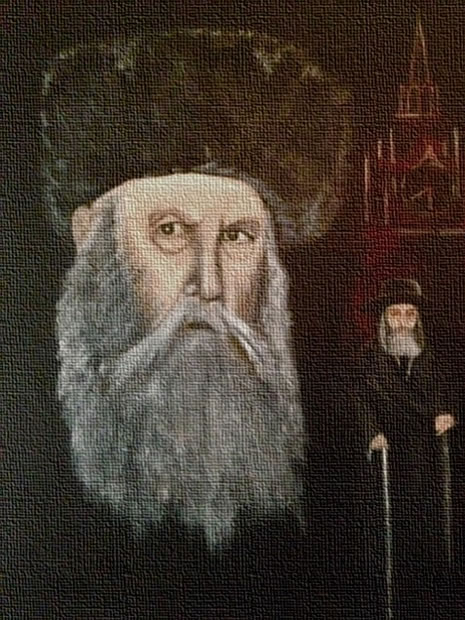
Chana Rivka began her journey to Judaism in her early 20s. At the same time, she began to paint. She took a break from painting when she married and had children, but later in life, when she moved to a Jewish community, the beauty of Judaism and the observant lifestyle motivated her to express her love for Torah through painting.
© Copyright 2015, all rights reserved.
| ||
Jewish News
| ||
This is the first in a series of articles on the unique lives of Chabad-Lubavitch yeshivah students. A series featuring the lives of female students is in the works as well.
Bochur: n. (baw-khur), lit. Selected one, commonly referring to a youth or young man (plural: bochurim). In common parlance, the word is used to refer to a yeshivah bochur, who devotes his time to Torah study. In Hebrew, a Chabad bochur is often referred to as a tomim (plural: temimim), a moniker given to students in Tomechei Temimim, the central Chabad yeshivah network.From standing on streets offering passersby the chance to perform a quick mitzvah to visiting Jewish residents in nursing homes to traveling to far-flung countries to support isolated Jewish communities as part of the “Roving Rabbis” program, Chabad yeshivah students—with their ubiquitous black hats, conservative suits and budding beards—have become familiar sights, particularly in New York and major North American cities. In Israel, too, and in countries around the world, bochurim can be spotted carrying velvet bags with tefillin at the ready, “just in case.” Yet the primary occupation of the bochur is to study Torah for many hours every day, delving into Hebrew and Aramaic texts that are the product of thousands of years of Jewish scholarship. Intrigued? Then take some time to learn about the learned life of the Chabad bochur. Who They Are ...As soon as a young man passes age 13—the age of bar mitzvah—he is often referred to as a bochur. However, it’s not until he reaches high school age that he fully adopts such a lifestyle, which can continue for a decade or so until he marries.A bochur’s life can be divided into four stages. 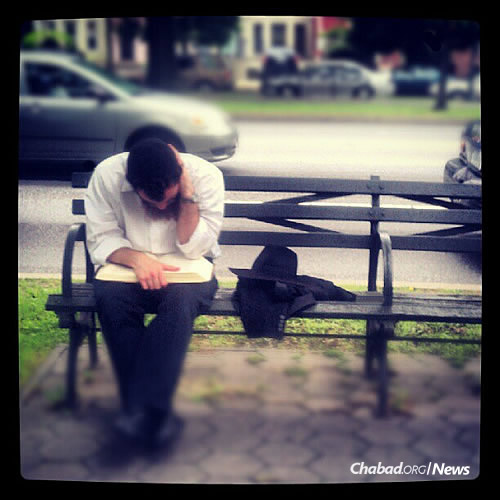
Deep in study on a bench along Eastern Parkway near Lubavitch World Headquarters in the Crown Heights neighborhood of Brooklyn, N.Y. (Photo: Mordechai Lightstone)
2. This is followed by a three- or four-year program called either bais medrash (“study hall”) or zal (which means the same thing in Russian-Yiddish); or yeshivah gedolah (“large yeshivah”). 3. Since the 1970s, this has been followed by a year of shlichus, when the students would be sent as the Rebbe’s emissaries to cities all around the world. Typically, they form the nucleus of ayeshivah at their destination cities. While some yeshivahs (such as the one in Melbourne, Australia) host students for two years, most are a one-year stint. This year is often a time of personal growth, as young men find themselves in positions of responsibility. 4. At this point, the student is typically in his early 20s and will begin studying the prerequisites for his semichah, rabbinic ordination. Many do so in the Central Chabad Yeshivah in Brooklyn, N.Y. Others join semichah programs in cities around the globe. By the time a student has completed his ordination at age 22 or 23, he is often ready to consider marriage and starting a family. 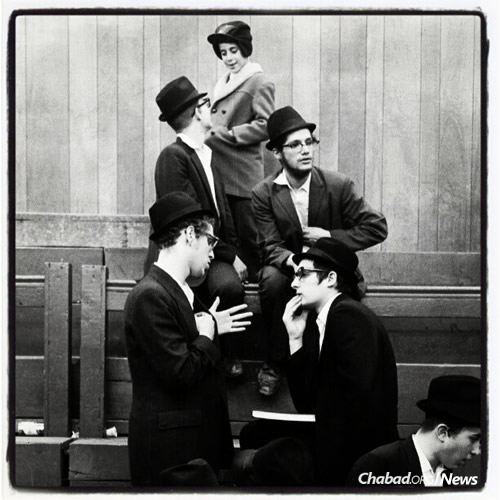
Yeshivah students in discussion at 770 Eastern Parkway, circa 1970. (Photo: Leonard Freed)
What They Do ...The yeshivah bochur’s schedule is comprised mostly of learning Torah. The study regimen in Chabad yeshivahs is based on the course of study established by Rabbi Shalom Dov Ber of Lubavitch, when he founded the Tomchei Temimim network of yeshivahs in 1897.The day begins with the study of treatises of Chassidic philosophy at 7:30 a.m., though sometimes earlier. By that time, many students have already immersed in the purifying waters of the mikvah.This study session is followed by morning prayers and breakfast. The juxtaposition of study and prayer is no accident. Rather, the deeply contemplative Chassidic texts, which meld Kabbalistic scholarship and an intense course of personal growth, lend the backdrop for a prayer experience that is both meditative and introspective. 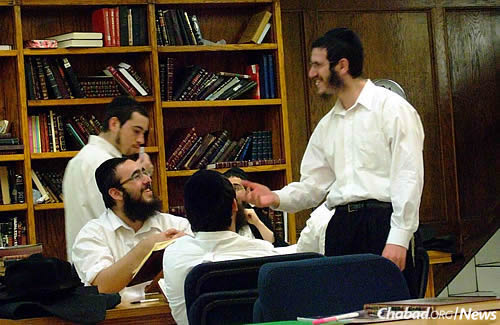
Yeshivah students engage in discourse at the West Coast Rabbinical Seminary in Los Angeles. (Photo: Mordechai Lightstone)
In addition to mastering the Hebrew and Aramaic works, the students toil to carve out an understanding that is uniquely their own, often publishing novel interpretations and queries in printed journals published by the yeshivahs. 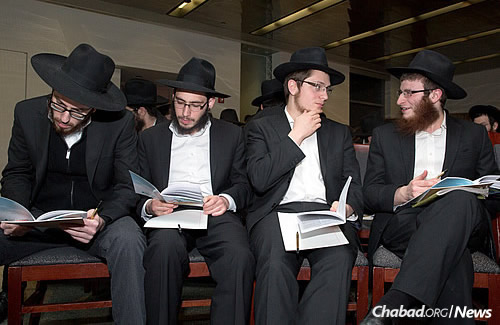
Discussing text and enjoying the camaraderie that goes with yeshivah life. (Photo: Bentzi Sasson)
The final period before the dinner break is devoted to the Shulchan Aruch (“Code of Jewish Law”), often the edition authored by Rabbi Schneur Zalman of Liadi, the first Rebbe of Chabad. Dinner is followed by another session of Chassidic philosophy. Depending on the age of the students, this session ends anywhere between 9 and 10 p.m., after which point many students will continue to study late into the night. 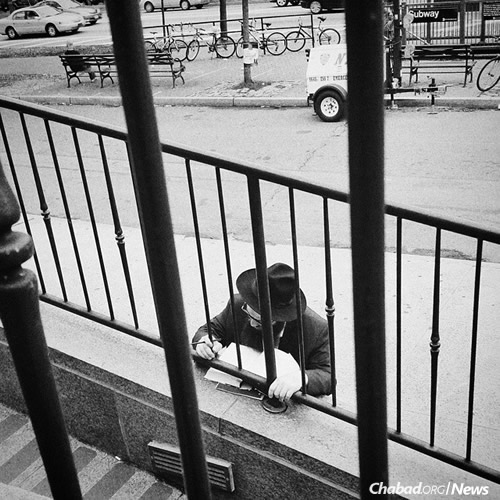
Never a spare moment: learning and leaning in front of Lubavitch World Headquarters in Brooklyn. (Photo: Mordechai Lightstone)
Although some students sleep at home, most—especially the older ones—study in out-of-town yeshivahs, living in dormitories. 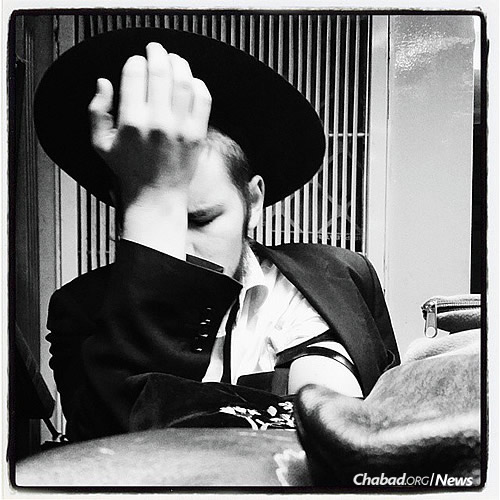
A yeshivah student engaged in prayer adjusts his tefillin. (Photo: Mordechai Lightstone)
Where They Go ...Another important element of the bochur’s lifestyle is the farbrengen, the informal get-together in which Chassidim share stirring melodies, stories, Torah thoughts and inspiration over refreshments and, for the older ones, small cups of spirits.The farbrengen is both uplifting and a serious springboard for the intensification of spiritual endeavors. Topics may include the redoubling of efforts in Torah scholarship, the refinement of character and other pertinent issues. Like all teens, bochurim may be seen reading, playing sports or just hanging out. 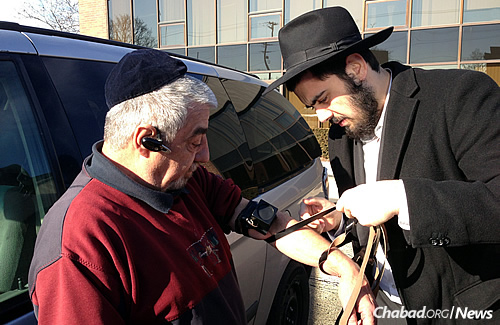
A mitzvah familiar to the yeshivah student: Helping a man don tefillin. (Photo: Lubavitch Mesivta of Chicago)
Often done in pairs, this is referred to as “going on mivtzoyim,” in Yiddish-influenced Chabad lingo. Participation is entirely voluntary, and bochurim commonly take pride in their accomplishments in this regard, often developing regular “routes” of people they visit on Friday afternoons, when their studies end earlier and they have some free time before Shabbat. In most cities, mivtzoyim routes grow organically, as bochurim network and meet more people to add to their routes. When a bochur transfer to a yeshivah in a different city, he will often try to take over an existing route that someone else has left. Sometimes, the routes are overseen by the “bochurim shluchim” described above. 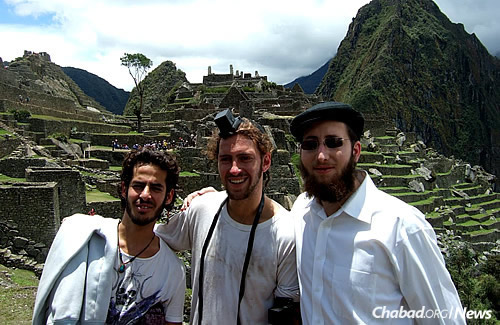
Putting on tefillin at Machu Picchu in Peru. (Photo: Mordechai Lightstone)
So the next time you happen to bump into a bochur, you know just a bit more about the fellow beneath the fedora. 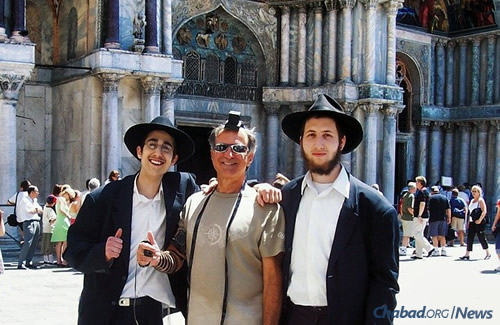
Two yeshivah students wrap tefillin with a Jewish man at the Piazza San Marco in Venice, Italy. The piazza was the site of a public burning of the Talmud in 1553. (Photo: Mordechai Lightstone)
© Copyright 2015, all rights reserved.
| ||
Jewish News
| ||
This is the third in a five-part series on Chabad’s impact on Jewish life in Argentina, one of the largest Jewish communities in the world.
BUENOS AIRES, Argentina—A broad, barrel-chested man, Gabi Levinsky rose to address 150 fellow parents gathered in the cafeteria of the Wolfsohn-Tabacinic School. It was Friday night, and children ran freely around the room as Shabbat dinner stretched late into the muggy Argentine evening. With tears in his eyes, Levinsky thanked the Wolfsohn community for standing with his family following the sudden passing of their daughter a year earlier. By the time his short speech was over, there wasn’t a dry eye in the room. Levinsky’s daughter, Julietta, had been a student at Chabad’s Wolfsohn-Tabacinic School, a nursery through seventh-grade Jewish day school in the Belgrano neighborhood of Buenos Aires. A lively, well-adjusted sixth-grader, she was set to begin bat mitzvah lessons with Lea Gurevitch, who with her husband, Rabbi Mendy Gurevitch, co-directs the Wolfsohn-Tabacinic Jewish day school and community center. “The truth is, we didn’t know the family that well,” says Rabbi Gurevitch. “Julietta was a student here, and my relationship with Gabi was cordial, but not much more than that.” Then tragedy struck. On Feb. 13, 2014, the Levinskys’ modest home experienced a gas leak. Most of the family—Gabi’s wife, Virginia; son Nico; and daughter Maggie—slept upstairs, but Julietta’s room was on the first floor, near the leak. Gabi managed to get to his eldest daughter and carry her out of the house, but by then, it was too late. “Julietta’s funeral passed by our school, and a very large number of community members came out,” recalls Gurevitch. “Many of them did not know the Levinskys at all, but they came as a community to show respect.” 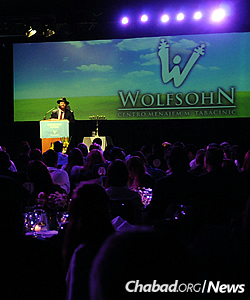
Rabbi Mendy Gurevitch, director of the Wolfsohn-Tabacinic Jewish day school and community center, addresses parents, alumni and supporters at the institution's annual dinner.
It was this community that stepped up to help the Levinsky family during their time of sorrow. The Levinskys had already been struggling, but their daughter’s death nearly pushed them over the edge. Following the accident, investigators deemed their home uninhabitable, and Gabi Levinsky himself was out of a job. A plan of action was made at a meeting initiated by a group of school mothers and beforeshiva had concluded, nearly everyone was involved. They found them an apartment and raised enough money to cover rent for a year, delivered food and purchased health insurance for them. Now, a year later, Gabi is working again. “There were times when I did not think we would make it,” Levinsky said to fellow parents that Friday night. “And we couldn’t have without Rabbi Mendy and this community.” 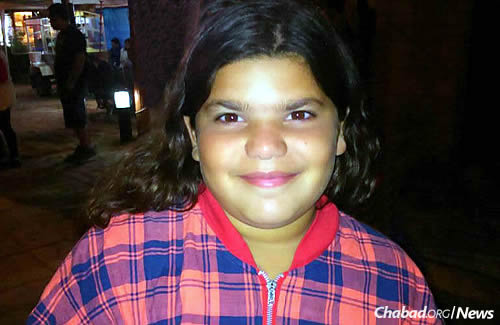
Julietta Levinsky, a sixth-grader at the school, passed away last year as a result of a gas leak in her home. The school community rallied around the family in the wake of the tragedy.
A Message From JuliettaThe loss of a child brings with it unimaginable pain for a parent, and although he had a roof over his head and food for his family, Gabi was depressed. He missed his daughter terribly, and nothing could change that. One evening a few days prior to the Shabbat dinner at which he spoke—as had occurred so many times over the course of the year—Gabi was in deep discussion with Gurevitch in the rabbi’s office.“He was telling me he just could not continue without his daughter,” says Gurevitch. “I told him that even when he doesn’t see his daughter, he can do positive things to remember her. Gabi wasn’t happy with that. He said he needed something more tangible—that he could actually see—and not just hear it from my words.” It was towards the end of the school year and Julietta’s class, now completing seventh grade, made a yearbook. In it, they included an essay written by Julietta before her passing. It was written from the perspective of telephone inventor Alexander Graham Bell’s daughter. “I’m far away from you father, and I miss you,” wrote Julietta. “I tried to send a letter with a pigeon, but I still feel distant.” Julietta’s next lines proved to be the answer Gabi was looking for. “I missed you, too, so I invented the telephone, a way we can stay connected,” reads Bell’s response. “Even when you don’t see me, we’re still connected.” Sitting in the school’s cafeteria on that late-summer Shabbat, with multi-colored skylights above and children’s art projects around them, the Wolfsohn-Tabacinic community joked together, drank together and cried together. And for the few outside observers joining them, it was clear that they were all part of one large extended family. 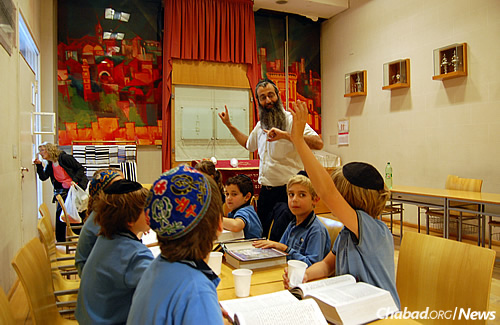
Wolfsohn's youth director Rabbi Gad Pichel runs after-school programs and extracurricular Jewish activities at the school.
A Series of Providential EventsWolfsohn was founded in 1906 as a Jewish community library before growing to encompass a school and synagogue. Wolfsohn—named after Zionist icon David Wolfson—served as the flagship school of the Conservative movement in Buenos Aires until 2004. Despite its long and proud history of academic excellence, the institution’s finances faltered in the 1990s, and following the Argentine economy’s severe crash in 1998, it was on the brink of collapse. Enrollment at the school had once topped 1,000, but the institution’s precarious finances left it with barely 150 students and heading towards imminent closure.Argentina’s financial depression was so severe and stretched for so long that at times, paper currency disappeared from the streets, leaving locals to barter in exchange for goods. Facing certain foreclosure, an attempt was made in 2004 to sell off Wolfsohn’s multi-storied edifices piecemeal. But when Rabbi Tzvi Grunblatt, Argentina’s head Chabad-Lubavitch emissary, was given the opportunity not only to purchase the buildings but the school itself, he jumped at the chance to keep the doors open. Today, he views the series of events leading to Chabad’s purchase of the school as providential. “One of the first things we did when we got to Argentina in 1978 was meet with the menahelet of the Wolfsohn school,” recalls Grunblatt. “She asked me then if I could give bar mitzvah lessons there, which I did. Twenty-six years later, Chabad took over operation of this same school.” With the substantial support of Miami-based philanthropist Moises Tabacinic, Chabad was able to save Wolfsohn. In memory of Tabacinic’s father, the institution was renamed the Menahem Mendel Tabacinic Center for Jewish Education-Wolfsohn School. 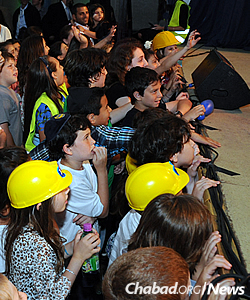
The school has developed into a full-fledged Jewish activity center, complete with a synagogue, classes and even entertainment.
“I saw Rabbi Grunblatt standing on a corner trying to flag down a taxi,” says Marcelo Brukel, the parent of four students at the school. “I recognized him and pulled over to offer the rabbi a ride.” Their conversation progressed quickly, and Grunblatt soon learned Brukel’s children attended a different school. “Why not send your children to Wolfsohn?” inquired Grunblatt of him. “We had been afraid that Chabad’s school would be too religious for me,” remembers Brukel. “But we agreed to go there for an interview and were impressed. Our family has been part of the Wolfsohn community ever since.” Diego Fainzaig’s experience was similar. The Fainzaigs are a well-established philanthropic family in Buenos Aires, together generously donating to Chabad and other Jewish causes in the country. Well aware of Grunblatt’s passion, Fainzaig nonetheless wasn’t expecting a call from him two weeks before the start of the school year, urging him and his wife to consider Wolfsohn-Tabacinic for their children. “The director had dust on his face from construction when we came to visit,” says Fainzaig, chuckling. “The next year we moved our youngest child to Wolfsohn, then our older ones. Now we have four children there. It was a very good decision for our whole family.” 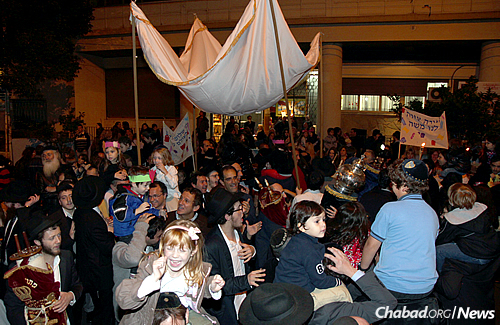
The street in front of Wolfsohn was shut down for a recent Torah-completion ceremony, with parents, students and congregants dancing on the Belgrano road as they made their way into the synagogue.
Changes Through the GenerationsJewish schools, youth groups and institutions have flourished culturally in Argentina for years. While these organizations may have succeeded at engaging an older generation of Argentines, many younger Jews assert that they have left theirs sorely lacking.“People my age—between 20 and 40—we are the children of the Conservative movement here,” explains Sebastian Vedronik, a Wolfsohn-Tabacinic parent who himself attended schools affiliated with that movement. “Our parents felt Jewish; they played in a Jewish football league, and they married Jewish. But they didn’t pass on enough to our generation, and for us, this has turned out badly. Out of my class in a large Jewish high school here, around 50 percent have intermarried.” Fainzaig describes the school he went to—he attended the same primary school as Vedronik—as culturally Jewish, but strongly against religion. “When I was 11, I remember our class made a mock Shabbat. I was the one to make a blessing on challah, and when I asked the teacher for a kipah before I made the blessing, she told me: ‘It is not important to whom you pray; this is just a custom.’ ” “For our parents, it was ‘Conservative,’ ‘Zionist’ or ‘Orthodox,’ ” says Vedronik. “Today, for younger people, it has become Jewish or not Jewish.” He and others credit Chabad with breaking down the barriers between what had always been considered the realm of the small, secluded Orthodox Jewish communities—Torah study and traditional observance—and the broader Jewish community of Buenos Aires. 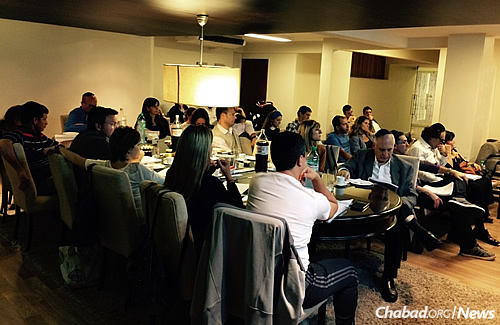
A Rohr Jewish Learning Institute (JLI) class given in newly renovated space at the Wolfsohn building. The classroom and library area was sponsored by the family of the late Argentine philanthropist Micki Rosenthal.
In part due to their own relatively weak Jewish upbringing, young families such as the Vedroniks and Fainzaigs choose to send their children to Wolfsohn-Tabacinic, known for its combination of grounded Jewish studies and rigorous secular education. Beyond the knowledge, they want their children to be active members of the Jewish community. “During Shabbat lunch, I ask my children what they learned about the Torah portion that week. The youngest starts, the next one adds something, and we go around the table,” explains Fainzaig. “It makes me so happy to be able to see this from my children—to see that they know things about Judaism that I never learned at such a young age. “My in-laws are less religious than my parents, but they’re happy, too. They see that my children attending this school, it’s not just about them repeating a story. It’s a way of life.” The Fainzaig family is now sponsoring the total refurbishment of the main hall, which will be named Salon Jaia Waisburg de Fainzaig, after the family’s matriarch. ‘One Big Family’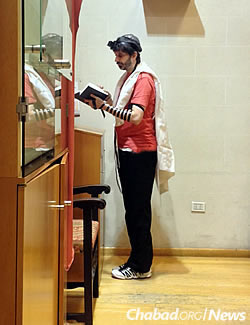
Diego Fainzaig has four children currently enrolled at the school. His family is sponsoring the refurbishment of the main hall, which will be named Salon Jaia Waisburg de Fainzaig, after the family’s matriarch.
“Another 30 years of Wolfsohn will change the Buenos Aires Jewish community in a big way,” says Moishy Groisman, also a school parent who attends the daily and Shabbat minyan. “Now people are joining not only because of the school, but because of the community. They come seven days a week. There are classes, a yeshivah at night for adults, Shabbat programs for the children. These people are our friends.” Parents credit the Gurevitches for how well the community has meshed and grown in recent years. Two years ago, they were joined by Rabbi Gad Pichel as youth director, who is responsible for extracurricular children’s activities at Wolfsohn-Tabacinic—such as father-and-son Torah study, Shabbaton trips and afterschool programs. With the assistance of CTeen International, this past April Rabbi Meir and Debi Plotka joined Wolfsohn-Tabacinic to direct the CTeen program there, reaching out to Jewish teenagers in the area as well as former students of the school who have moved on to various Jewish and non-Jewish high schools in the area. 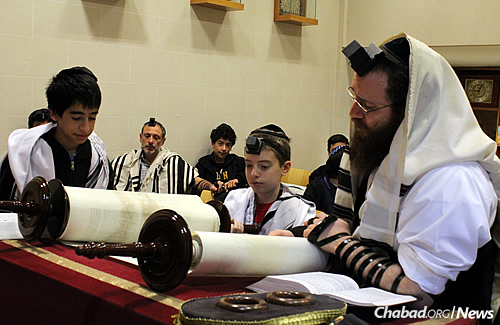
Shacharit morning prayers at Wolfsohn. Gurevitch, right, reads from the Torah as a student receives an aliyah.
“When we started here, the community wasn’t really born yet,” states Fainzaig. “We didn’t do much here besides for drop our children off. After Rabbi Mendy came, things started to change quickly. He has appeal, he has a way of making people feel comfortable, so the community started to grow. This has become one big family.” “If I wasn’t part of this community, I would not know how to have a Jewish home,” adds yet another school parent, Fabian Bukschtein. “I learned everything here.” The first article in the series, “How Chabad Took Root in Argentina: The Early Years” can be read here. The second article in the series, “Step by Step, Chabad Makes Inroads, and Friends, in Argentina” can be read here. 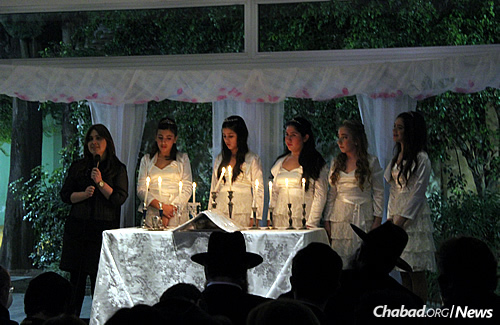
A bat mitzvah ceremony at the school, with the young women lighting symbolic Shabbat candles and receiving their own set of candle holders. At left is Wolfsohn's co-director, Lea Gurevitch.
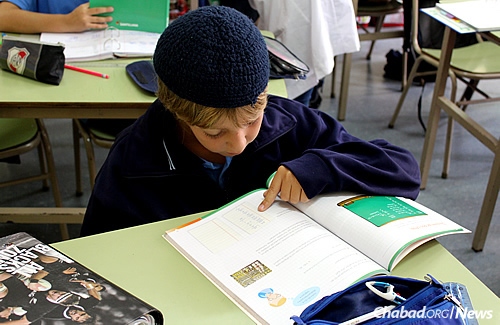
Students from across the spectrum of the Buenos Aires Jewish community attend the Chabad-run school.
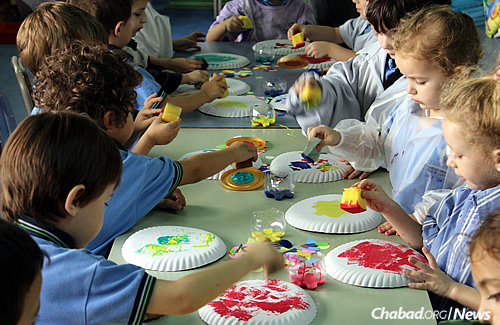
In Argentina, schooling traditionally begins at preschool, running through elementary school, which ends after seventh grade.
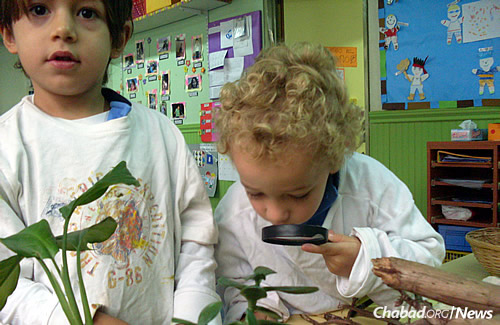
Over the course of its long history, Wolfsohn has been known for top-notch academics, a tradition it has maintained in the years since Chabad has taken over management of the school.
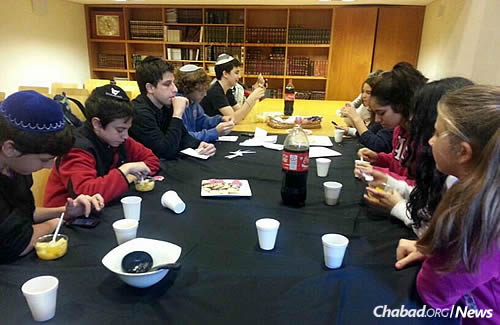
A teen club meets regularly at Wolfsohn, which plans on opening a high school in March 2016 to serve its elementary-school graduates.

Chabad's Wolfsohn-Tabacinic nursery through seventh-grade Jewish day school in the Belgrano neighborhood of Buenos Aires
© Copyright 2015, all rights reserved.
| ||
Jewish News
| ||
CHICAGO—It was a bittersweet event, filled with the conflicting emotions that come with extreme sadness mingled with joy. You could sense the powerful feelings, blending in the air along with the fuzzy white confetti drifting down from the cottonwood trees above.
Hundreds of men, women and children from across the Jewish community marched down the streets on Sunday bearing flags and little bottles of water thoughtfully provided along the way; it was a humid start to the first official day of summer. They were there to welcome a new Torah scroll, carefully written on a long roll of parchment. Amid the loud music and cries of congratulations was a profound sadness. The Torah was written in memory of Gabriel and Gayle Sassoons’ seven children, who perished in a March 21 fire that tore through their home in Brooklyn, N.Y. (Gayle Sassoon, who remains in a coma, and their 15-year-old daughter, who was released from the hospital last month, survived.) A number of other cities will welcome Torahs in their memory, but the one in Chicago was the first. Rabbi Baruch Hertz, rabbi of the Chabad community in Chicago, noted that the event was the result of a widespread effort spanning the entire community. There were no official sponsoring organizations or congregations listed on the advertising material; it was for every member of the Jewish nation, all connected to a single grieving family. 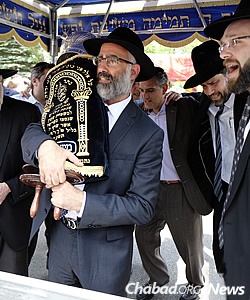
Sassoon carried the Torah under a chuppah on wheels as part of a communal procession. (Photo: Deja Views)
His suit was pressed, his hat was brushed and his tie was straight, but he looked like a man living on a different plane—a man too wrapped up in his own thoughts to take notice of what was going on around him. “Where are my children?” I could imagine him thinking as he shuffled through the proceedings. The music was loud, perhaps a touch too loud, and my 3-year-old snuggled her sweaty head into my shoulder, begging to go back to the quiet of the car. But the others were pulling forward, eager to take part in the festivities, especially my 6-year-old son, who wanted to dance with the Torah. Finally, we broke through the crowd to the inner circle of men and boys dancing around the Torah as it slowly made its way to the synagogue. Clasping the hands of those nearest us, we bobbed and swayed to the words: “The Torah of the L-rd is perfect; it revives the soul.” Later on, Gabriel Sassoon would speak passionately about how the Torah revives his soul as he struggles to absorb the loss of his children. 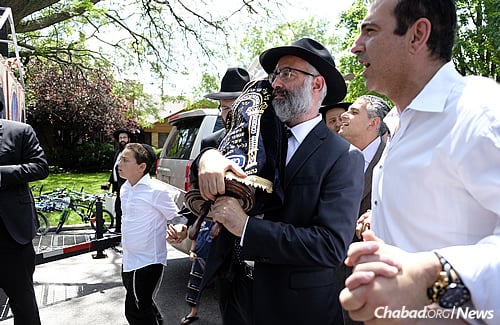
Hundreds from across the Chicago Jewish community marched down the streets to accompany the Torah to its new home in the ark of a neighborhood Sephardic synagogue. (Photo: Deja Views)
‘Soul of the People’As I danced with my son, I kept wondering if all the children teeming about only reminded him of his own.And then it happened. As Mr. Sassoon cradled the new Torah in his arms, my son innocently pulled his hand out of mind and brushed his fingers against the Torah’s velvety mantel, and brought them to his mouth to kiss them. It was painful to see—my son kissing the Torah held by a man who had lost his sons and daughters. Tears mingled with sweat, and a choked sob became part of the song as we continued to dance around the Torah. “Where were his children?” I wondere. “How can this whole event take place, and how can we be so happy when those poor precious children are not there? How can we sing and dance as if nothing is wrong?” Finally, the parade wound down. We brought the Torah to its new temporary home in the ark of a Sephardic synagogue in the neighborhood, where it took its place amongst its peers, each in an ornate cylinder case, true to the custom of the Jewish communities of Asia and North Africa. 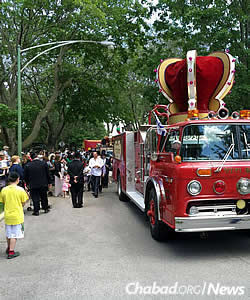
The parade was led by a retro-fitted firetruck, complete with a crown to mark the occasion.
Mr. Sassoon got up to speak. Suddenly, he was alive and animated. The forlorn-looking man was converted to a powerful orator who spoke with strength and conviction. “The Torah is the soul of the Jewish people; it unites us and it lives forever,” he declared. “The soul is eternal, and the souls of my children live on through the holy letters of this Torah.” “There is so much joy in toiling in Torah, and there is so much happiness to be found in mitzvahs,” he exhorted his audience. “Show your children how much you enjoy learning Torah! Make sure they see how much there is to enjoy in the observance of the holidays, and make sure to involve each and every one of them!” And then, I realized that I had my answer. His children were there with us in the room. They were there in the Torah, and they were there in the tiny joyous changes that would be brought to hundreds of home starting today. His children had become ours. 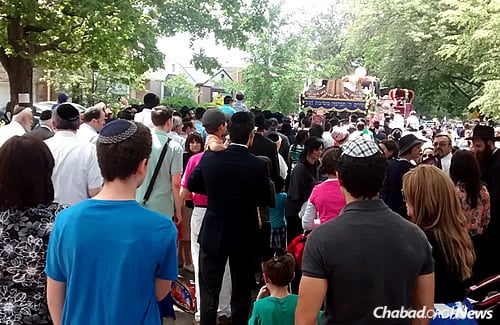
The crowd came out in full force to support a father who has lost so much. Sassoon's wife, Gayle, and 15-year-old daughter survived and are in the process of recovering.

Rabbi Baruch Hertz, rabbi of the Chabad community in Chicago, here with two of his children, noted that the event was the result of an effort spanning the entire community. (Photo: Deja Views)
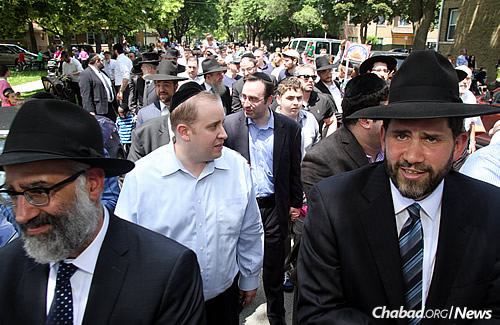
Men, women and children accompany the Torah to the sounds of music, expressing joy even in the midst of great sorrow. (Photo: Deja Views)
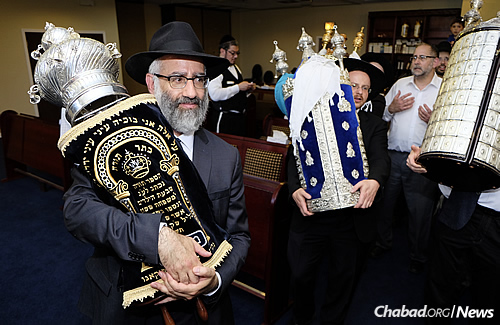
Sassoon entering the synagogue with Torah in tow. (Photo: Deja Views)
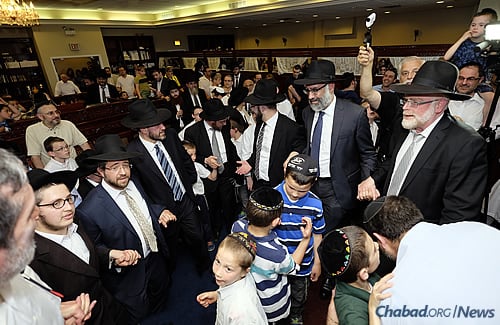
Men and boys danced inside the synagogue to celebrate the new Torah's arrival. (Photo: Deja Views)
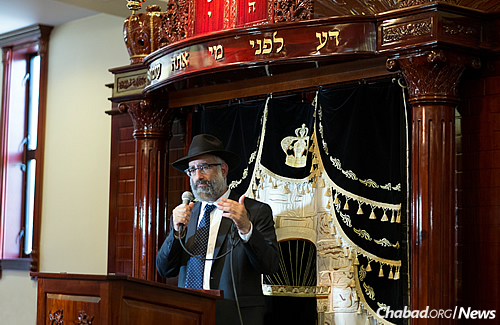
Sassoon addressed the audience, speaking powerfully and emotionally, saying “the souls of my children live on through the holy letters of this Torah.” (Photo: Deja Views)
© Copyright 2015, all rights reserved.
| ||
Jewish News
| ||
Bernard Baumgarten of Sunrise, Fla., says his situation is all too common.
Past his 90th birthday, he is looking for a place to live where he and his wife, Lily, can enjoy the rest of their golden years without having to bother with shopping or cleaning. And he also doesn’t want to compromise their religious ideals: He wants there to be a synagogue close enough for them to walk to on Shabbat and Jewish holidays. Baumgarten says he’s pinning high hopes on Aishel House, a proposed assisted-living community to be constructed on land adjacent to the Synagogue of Inverrary–Chabad in Lauderhill, Fla., where he currently prays and attends functions throughout the week. In addition to supplying glatt-kosher food—the only option for religious Jews like the Baumgartens—the location of Aishel House will allow residents with limited mobility to be brought over to the synagogue for prayers and celebrations. An additional bonus will be that children from Chabad’s preschool and youth groups will regularly visit and interact with the seniors to forge mutually beneficial relationships. Research and anecdotal evidence have shown that both groups thrive on such interaction. 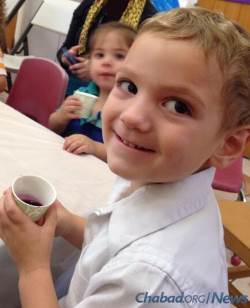
Chabad preschool students and youth groups will join in programming with the seniors.
‘A Real Need’“It would be heaven sent for us,” says Baumgarten, who relocated from Brooklyn, N.Y., to South Florida 25 years ago. “Thank G-d, we can both look after ourselves and I can still drive, so we do not need to live in a nursing home, but there really aren’t any assisted-living facilities in the area that cater to observant Jews such as ourselves.”“The inspiration for Aishel House,” explains Rabbi Levi Chanowitz, director of development at Chabad of Inverrary, “came to Rabbi Aron Lieberman, who has led our congregation since 1982. Over the years, he has seen many congregants grow older and saw the acute need for an assisted-living facility that would allow them to maintain the high level of Jewish involvement they’d grown accustomed to.” 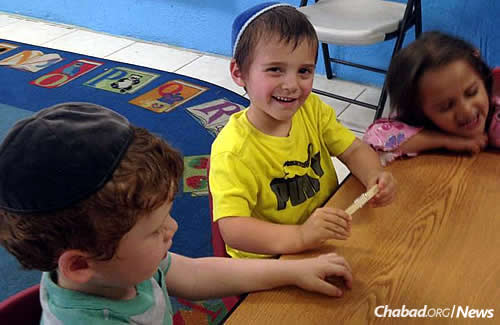
Studies have shown that bridging the generations is beneficial to all age groups.
Lieberman—co-founder and current president of the Orthodox Rabbinical Board of Broward and Palm Beach Counties, and regional director of Chabad in the Greater Fort Lauderdale area—will serve as a consultant on all matters, religious and ethical. He is tasked to ensure that the facility run in accordance with Torah values, and that it will serve as an attractive option for those seeking to live in a wholesome Jewish environment. At the same time, Chanowitz is quick to point out that the new entity will offer the same open-door policy that typifies the Chabad House experience: welcoming Jewish people from all backgrounds and levels of observance, as well as non-Jews. With the facility in the final planning stages, Chanowitz reports that interest is steadily growing in the senior community. “People are excited; they’re calling and they’re asking” about it, he says. “There is a real need for this kind of solution, and we look forward to being there for our seniors in this stage of their lives.” For more information, visit the Aishel House web site here. 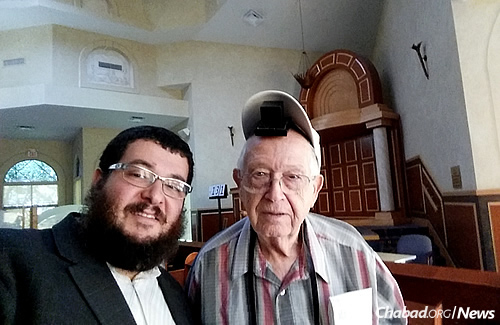
Rabbi Levi Chanowitz, director of development at Synagogue of Inverrary–Chabad in South Florida, with congregant Michael Kahan.

Artist's rendering of the new Aishel House, which is expected to open in January of 2017.
© Copyright 2015, all rights reserved.
|
Chabad.org Magazine - Editor: Yanki Tauber
____________________________
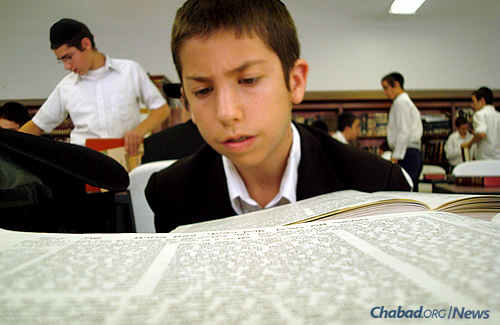
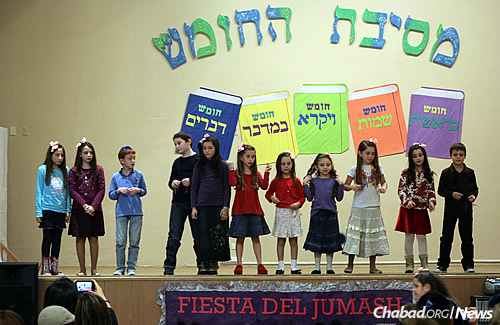
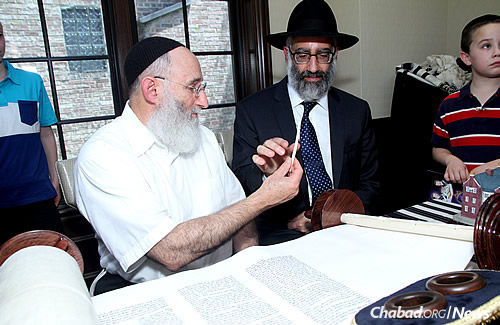
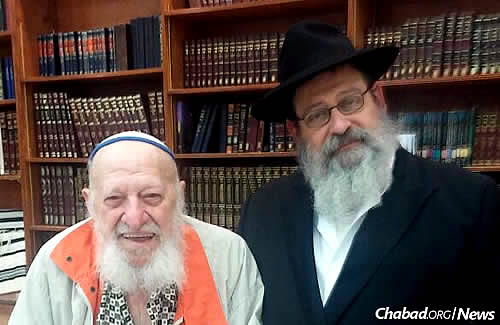
No comments:
Post a Comment